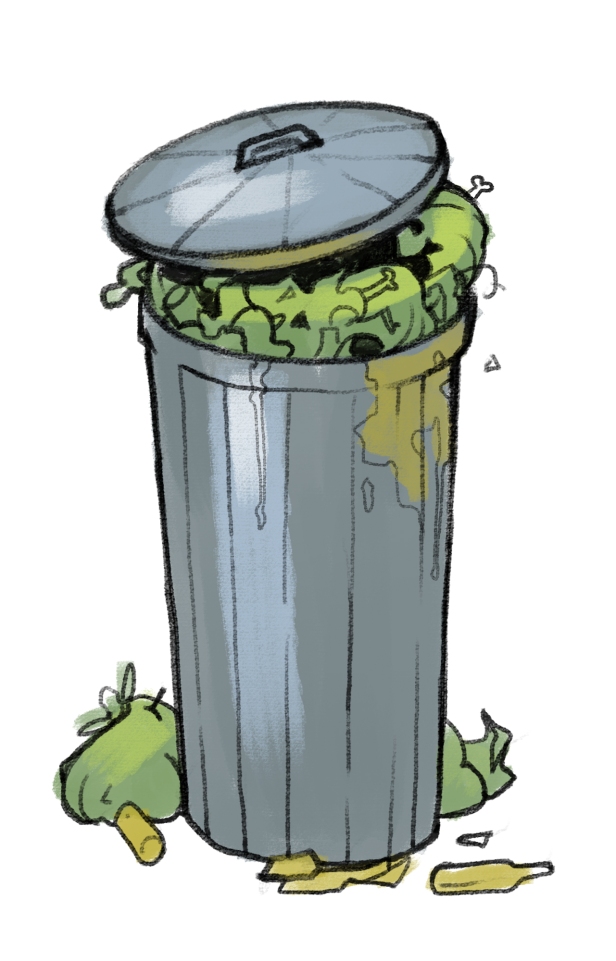It’s lunchtime on a Wednesday afternoon at Carleton University. The Fresh Food Company (FFC)—the university’s only buffet-style dining hall—is flurried with activity. There is barely an empty table in sight as hundreds of hungry students take time away from their books to enjoy a meal. A constant stream of people move through the waste area, where one by one plates are scraped into bins and the contents of half-empty glasses are poured down the sink. All this unfinished food contributes to the rising food waste epidemic across the globe.
FOOD WASTE IN CANADA
Canadians love to eat, but in recent years their food consumption habits have resulted in exponential levels of waste. In fact, food waste in this country is on the rise, according to a 2014 study conducted by Value Chain Management International Inc. (VCM), an Oakville, Ont. consulting firm that has co-authored several publications on the matter.
Canadians wasted $31 billion worth of food in 2014, compared to $27 billion in 2010, which is greater than the total economic output of the world’s 29 poorest countries, according to the study.

The study added Canadians throw out seven billion kilograms of edible food annually.
Although Carleton students may not visualize their half-eaten eaten pasta or discarded pizza slice in a landfill, the VCM International study reported that the average Canadian will waste 200 kilograms of food this year.
1.3 billion tonnes of food—a third of the food produced for human consumption—is wasted every year across the globe.
— Food and Agriculture Organization of the United Nations
HOW DOES THE FRESH FOOD COMPANY DEAL WITH FOOD WASTE?
Stephanie Carr is a second-year global and international studies student at Carleton who lived in residence last year. She said she tried her best not to waste food when she ate at the dining hall every day.
“I only take what I think I’m going to eat,” she said. “I usually finish my plate.”
Each day, approximately 7,100 people will pass through the heavy double doors of the FFC, and an other 11,000 to 12,000 will be fed at the dozens of quick-service outlets on campus, according to David Van Dyk, the district manager of Carleton’s dining services.
Van Dyk added that all the food services on campus serve a university population of more than 28,000 people.
He said he believes that despite the inevitable food waste occurring in a university
setting, the FFC is one of the most sustain able food services operations in the city.
“Anything that is coming out of the front of house from the Fresh Food Company is all compostable. It’s all green binned,” Van Dyk said.
Over the last three years, Van Dyk said dining services has strived to reduce food waste through education, awareness, and training. He said staff are cautious not to overproduce, but when there is extra food they have the capacity and equipment to store it properly, so it can be re-used during the next day’s meal service.
Van Dyk added that dining services has also implemented a number of sustainability
practices, including recycling all fryer oil from its on-campus restaurants, and the use of clear bins so staff get a visual of food waste.

“We instituted a food management program about three years ago on campus that
actually measures the waste. Our staff are actually weighing what they’re throwing out,”
he said. “Right away we saw a good reduction on our waste numbers.”
According to data provided by Van Dyk, about 198,000 kilograms of broken down organic materials are trucked away from the FFC in an average year.
REDUCING FOOD WASTE IN THE COMMUNITY
Despite Carleton’s dining services’ commitment to reducing food waste throughout
its outlets, student groups on campus remain troubled by Canadian food waste numbers.
The Carleton Food Collective, also known as the G-Spot, is a volunteer-based campus organization that collects food that would otherwise be wasted by grocery stores to provide free, healthy meals for students.
Etienne Lefebvre, a fourth-year cognitive science student at Carleton and volunteer with the collective, said most grocery stores the collective partners with waste about 20
per cent or more of the food in their inventories.
Lefebvre said there are many reasons why stores waste food, including the fact that an
imperfect-looking product is tough to sell.
He added that grocery stores are stocked with “so much food that they know some will have to be thrown out.”
The bulk of the collective’s work is soliciting and collecting food donations—such as apples that may be slightly bruised but still edible—and transforming them into nutritious meals for students, according to Lefebvre.
Lefebvre said he is concerned that food retailers and restaurants still think throwing out perfectly good food is just part of doing business.
“I’ve seen truckloads of food just thrown out,” he said.
The volume of food wasted daily by consumers, producers, and businesses is especially concerning to those helping feed the hungry in the Ottawa area.
Samantha Ingram, the communications co-ordinator for the Ottawa Food Bank, said
consumers should be wary of how much food is in their carts during their routine trips to the grocery store.
She said having a realistic grocery budget for the month is key to preventing food from
spoiling before it’s eaten.
While many see waste as a routine part of the food cycle, Ingram said her organization
tries to make donated food go the extra mile.
“We do our part to try and do as much food recovery as possible . . . we try and eliminate food waste,” she said.
The Ottawa Food Bank collects donations from places throughout the city, including the Canadian Tire Centre in Kanata. Ingram said the event centre often offers prepared food left over from concerts and hockey games so it can become a meal for someone in need.
“We can pick [the food] up while it’s still warm and we’ll deliver it directly to a food
program that will be able to serve it almost immediately,” she said.
The Ottawa Food Bank also partners with major grocery chains, like Loblaws, through its reclamation program, where dented cans, crushed boxes, and other food items that can’t be sold on store shelves are donated and reused, according to Ingram.
She said the Ottawa Food Bank supports 140 food programs across Ottawa, including
downtown shelters and children’s breakfast programs, which together help feed an estimated 50,000 people each month.
LOOKING AHEAD AT COMBATING FOOD WASTE
Carr said she used to work at a hotel restaurant and saw tons of food wasted all the time.
“Places like the cafeteria, or hotels, or other restaurants should definitely partner with . . .
shelters that give a meal to people,” she said.
Van Dyk said although Carleton’s dining services would like to be able to donate leftover food to community groups, he is worried that some food programs may not have the proper equipment to store food properly, which could result in food borne illness.
“With leftover food you have to be very careful,” he said. “Giving it out is a challenge
for a lot of reasons.”
But Van Dyk said dining services partners with Feed the Homeless By U, an on-campus student-led organization which provides hot and healthy meals to those living in poverty. He said chefs at the FFC prepare all the food and accompany the students downtown to distribute the meals.
“We go once a month with that group and we’re providing 150-200 meals to the homeless,” Van Dyk said.
As for the average student who is too full to finish their meal, Phillip Mansfield, the manager of sustainability programs at Carleton, said their only option at the moment is to discard their food as general waste.
“We do compost, it’s about 10 per cent of all waste generated, . . . but a lot of our focus at the moment has been about kitchen waste,” Mansfield said. “So, waste that comes out of the food court, and waste that comes out of the Fresh Food Company, the waste produced by the kitchens, and the waste students get rid of when they clear their plates.”
He said the University of British Columbia and the University of Ottawa have public compost bins, but they have big issues with compost contamination when items are not disposed in the proper bin.
Since there is virtually no leeway for contaminated compost, any contamination means waste collectors reject the bags and it goes to the landfill, according to Mansfield.
“If you put in a chopstick, or a bit of plastic, or a can, suddenly that whole bag is contaminated,” he said. “You can’t use that whole bag in compost.”
Although Mansfield said he is worried about waste contamination because it can be as much as 30 per cent in some areas on campus, his aim is to roll out more composting projects on campus, such as extending the pilot green bin programs in Russell, Grenville, and Leeds residences.






